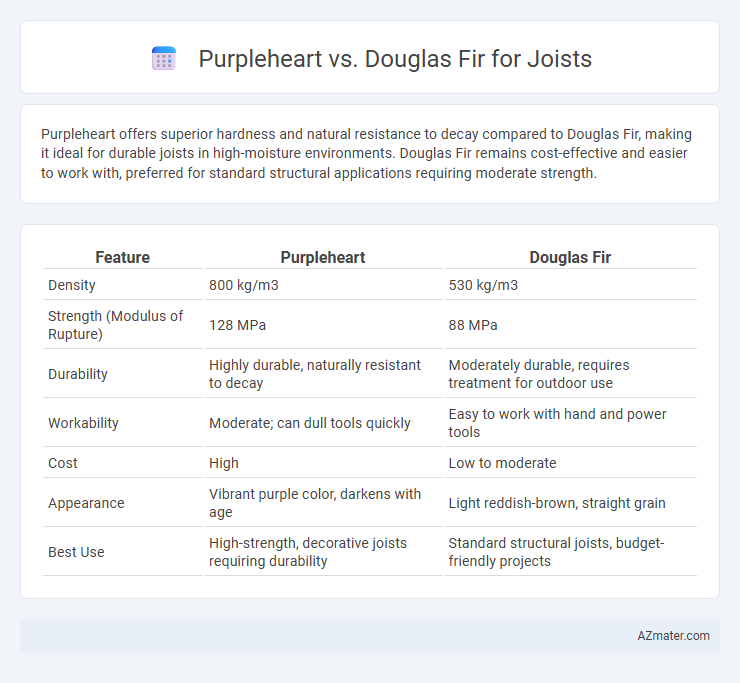Purpleheart offers superior hardness and natural resistance to decay compared to Douglas Fir, making it ideal for durable joists in high-moisture environments. Douglas Fir remains cost-effective and easier to work with, preferred for standard structural applications requiring moderate strength.
Table of Comparison
| Feature | Purpleheart | Douglas Fir |
|---|---|---|
| Density | 800 kg/m3 | 530 kg/m3 |
| Strength (Modulus of Rupture) | 128 MPa | 88 MPa |
| Durability | Highly durable, naturally resistant to decay | Moderately durable, requires treatment for outdoor use |
| Workability | Moderate; can dull tools quickly | Easy to work with hand and power tools |
| Cost | High | Low to moderate |
| Appearance | Vibrant purple color, darkens with age | Light reddish-brown, straight grain |
| Best Use | High-strength, decorative joists requiring durability | Standard structural joists, budget-friendly projects |
Introduction to Purpleheart and Douglas Fir as Joist Materials
Purpleheart is a dense hardwood known for exceptional strength, durability, and natural resistance to decay, making it ideal for heavy-load joist applications. Douglas Fir, a softwood with high strength-to-weight ratio and consistent grain, is widely used in construction for its structural reliability and ease of workability as joist material. Both woods offer distinct benefits, with Purpleheart excelling in long-term durability and Douglas Fir providing cost-effective, strong support in framing.
Physical Properties Comparison: Strength and Density
Purpleheart joists exhibit higher strength and greater density compared to Douglas Fir, making them ideal for applications requiring superior load-bearing capacity. The density of Purpleheart typically ranges from 800 to 900 kg/m3, significantly surpassing Douglas Fir's average density of 530 to 560 kg/m3. This increased density translates into enhanced stiffness and durability, while Douglas Fir remains favored for its balance of strength and lightweight characteristics.
Durability and Resistance to Decay
Purpleheart offers exceptional durability and high resistance to decay, making it an excellent choice for joists in humid or outdoor environments. Douglas Fir provides moderate durability with less natural resistance to decay, often requiring treatment to withstand moisture and insect exposure. Purpleheart's dense, oily nature ensures longer lifespan and structural integrity compared to Douglas Fir in demanding conditions.
Workability and Ease of Installation
Purpleheart offers excellent workability with fine, straight grain that machines smoothly and holds fasteners securely, making it ideal for precise joist fabrication. Douglas Fir, prized for its lightweight and stiffness, is easier to handle on-site and cuts with common tools, facilitating faster installation with minimal effort. Both woods provide solid performance, but Douglas Fir's ease of cutting and nailing often results in quicker joist installation compared to the denser Purpleheart.
Cost Analysis: Purpleheart vs Douglas Fir
Purpleheart joists typically cost significantly more than Douglas Fir due to their exotic hardwood status and superior durability, with prices often ranging from $10 to $15 per board foot compared to Douglas Fir's $3 to $5 per board foot. Despite the higher initial investment, Purpleheart offers greater resistance to decay and insect damage, potentially reducing long-term maintenance and replacement costs. Douglas Fir remains a budget-friendly option favored in construction projects where cost efficiency is paramount and lifespan requirements are moderate.
Environmental Impact and Sustainability
Purpleheart is a dense tropical hardwood known for its durability and resistance to decay, often sourced from sustainably managed South American forests certified by FSC, ensuring reduced environmental impact. Douglas Fir, native to North America, has a faster growth rate and is frequently harvested from well-managed plantations, offering a renewable resource with lower embodied energy. Choosing Douglas Fir can support carbon sequestration and habitat conservation efforts due to its widespread availability and sustainable forestry practices, while Purpleheart's slower growth and exotic origin may contribute to higher transportation emissions and potential overharvesting concerns.
Aesthetic Differences in Joist Applications
Purpleheart joists showcase a striking deep purple hue that naturally darkens to a rich brown over time, offering a unique and luxurious aesthetic for exposed wood structures. In contrast, Douglas Fir features a warm, golden tone with prominent grain patterns, providing a classic and timeless look favored in traditional and modern joist applications. The choice between these woods depends on the desired visual impact, with Purpleheart delivering bold color differentiation and Douglas Fir offering subtle warmth and versatility.
Load Bearing Capacity in Structural Uses
Purpleheart wood offers a significantly higher load-bearing capacity than Douglas Fir, making it more suitable for structural joists in heavy-duty applications. With a density around 800 kg/m3 and a modulus of rupture averaging 20,000 psi, Purpleheart can support greater weight and resist deformation better than Douglas Fir, which typically has a density of 530 kg/m3 and a modulus of rupture near 11,000 psi. In structural uses requiring maximum strength and durability, Purpleheart ensures enhanced stability and longevity compared to the more common but less robust Douglas Fir.
Maintenance Requirements Over Time
Purpleheart joists require minimal maintenance due to their natural resistance to rot, insects, and decay, reducing the need for frequent treatments or sealing. Douglas Fir, while strong and widely used for joists, demands regular maintenance such as sealing and inspection to prevent moisture damage and insect infestation. Over time, Purpleheart's durability offers lower upkeep costs compared to the more maintenance-intensive Douglas Fir.
Best Use Cases for Purpleheart and Douglas Fir Joists
Purpleheart joists are ideal for applications requiring exceptional hardness, durability, and resistance to decay, such as outdoor decks, heavy-load bearing floors, and marine structures. Douglas Fir joists excel in residential and commercial framing due to their high strength-to-weight ratio, ease of machining, and cost-effectiveness, making them suitable for standard floor joists and interior construction. For projects demanding superior weather resistance and longevity, Purpleheart outperforms, while Douglas Fir remains optimal for general structural support with efficient installation.

Infographic: Purpleheart vs Douglas Fir for Joist
 azmater.com
azmater.com